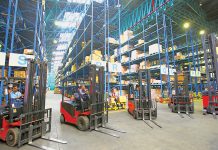Khursheed Alam, Co-Founder, Atmos Systems talks about the need to invest in cutting-edge innovations, advanced technologies such as AI, Block Chain, IoT and Data Science and smart warehousing solutions such as ACR Systems, sortation systems, ASRS Systems, DWS System and focusing on training the workforce to stay ahead and grow.
Ritika Arora Bhola
Please tell us about the genesis of your business operations in India? Please elaborate on services offered?
Atmos Systems has been providing automation solutions to manufacturing industry since the last three decades, under the umbrella of Saifi. It has worked with companies such as Eicher, Godrej, Honda and HP, to name a few. To better serve other sectors with our experience, we went back to the drawing board and conducted extensive R&D on how we could improve the warehouse automation business in the country. We introduced Atmos after two years of hard work, while refining our approach for the specialised market. In the segment, we implemented cutting-edge innovations and invested in newer technologies such as ASRS, AGV, and ACR systems. Automated processing is becoming smarter, faster, and efficient, thanks to our tech-enabled products. We are focusing on R&D to solve the existing warehouse automation issues. With our solutions in place, a one-acre warehouse could be managed by only five personnel, demonstrating the magnitude of the difference we can make.
How are e-commerce players leveraging warehousing solutions for seamless product delivery?
Many companies has invested have been putting a lot of money into automation technologies. The goal is to automate inbound, internal material handling, and outbound products transportation, while keeping human involvement to a minimum. Hundreds of stocks arrive in a warehouse, each containing a variety of commodities that must be stored in a specific slots. The former method was manual, requiring labour to physically transport and store the goods. However, with the introduction of newer smart warehousing solutions such as ACR Systems, sortation systems, ASRS Systems, DWS Systems, automation begins inside the truck. When they are moved inside warehouses, inventory is recorded, products are sorted out as per various attributes, and then shifted to designated locations and shelves using sophisticated material handling systems.
How warehousing automation is contributing to smart city-infra?
There are indirect ways in which it can be beneficial. People, frequently leave their houses to go shopping, especially if they need something right away. This exacerbates traffic and pollution problem. Increased warehouse automation can assist improve the situation by guaranteeing that people receive their products in the shortest amount of time thereby allowing them to complete their shopping, while sitting at home. It is the ripple effect of warehouse automation that can truly help with smart city infrastructure. Another big benefit is that as more warehouses become automated, business options will expand without the need to open a shop. While it is easier to offer things without hassle, one’s purchasing power increases as well.
Kindly throw light on some of the recent advancements done by your company which have been integrated or used by the logistics sector?
Today, e-commerce is shaping the whole logistics industry by integrating them as delivery partner across the nation. Many logistics companies are fulfilling ecommerce orders and facilitating them by providing warehousing space across many cities. As we are committed to provide smart solutions to warehouses, logistics sector is benefited from it. With the help of automation, various warehouse tasks such as picking, sorting and packaging can be automated.
What are the major hurdles when it comes to providing tech solutions to warehouse operators?
The major challenge is to teach or train warehouse operators on how to work with robots under one roof and how to properly handle the automated tools and use the programme commands.
Do you think tech adoption rate is slow in India compared to foreign nations?
In India, companies are keen to adopt new technology, but due to lack of knowledge, skilled labour and high investment cost, the implementation of new technology is slow as compared to the foreign nations. Stakeholders will have to understand that advanced tech such as robotics, AI, Blockchain, IoT will help them stay ahead in the competition and capture more market share. The Indian government should bring in new policies to encourage firms to invest in latest technology. Simultaneously, the companies should educate workers on the fear of job loss due to implementation of new technology in the system.
How do you dream to see the Indian logistics and warehousing industry in the near future?
The Indian logistics and warehousing industry is stabilized and has started re-organizing their strategies for the future. With the change in consumer behaviour and online shopping, the companies have decided to open micro-fulfillment centres across many cities to fulfill the customer demand in less time. For proper execution of supply chain operations, those firms in logistics and warehousing industry have to switch to automation from outdated manual workflows. In the years to come, we can see the dominance of automated tools and robots in Indian warehouses, where they would manage every aspect of order fulfillment process.
Please throw light on the kind of investments done in technology by your company?
We are moderately investing in innovation and as a growing brand, our focus is to develop efficient automation solutions that will replace repetitive tasks and speed up any process that requires a significant amount of time and effort of our customers. We have recently introduced Autonomous Case-handling Robotic System in the Indian market, which can improve the warehouse’s storage density and operational efficiency.












